The manufacturing industry is constantly evolving, seeking innovative and efficient methods to streamline production processes. One such advancement in sheet metal fabrication is the sheet roll forming machine. This remarkable piece of equipment has revolutionized the way sheet metal products are manufactured, offering numerous advantages over traditional methods. In this article, we will explore the intricacies of sheet roll forming machines, their working principles, applications, and key factors to consider when choosing the right machine for your production needs.
1. Pendahuluan
In today’s fast-paced manufacturing world, efficiency and precision are paramount. Sheet roll forming machines have emerged as a game-changer in the sheet metal industry, providing manufacturers with an automated and highly efficient solution for producing a wide range of metal profiles. Whether it’s for roofing, wall cladding, automotive components, or other applications, sheet roll forming machines offer unparalleled versatility and cost-effectiveness.

2. What is a Sheet Roll Forming Machine?
A sheet roll forming machine is a specialized equipment designed to transform flat metal sheets into custom-shaped profiles with consistent cross-sections. It operates by gradually bending and forming the sheet metal as it passes through a series of rollers and tooling stations. This process ensures accurate dimensions, uniformity, and high production rates.
3. How Does a Sheet Roll Forming Machine Work?
The working principle of a sheet roll forming machine involves a continuous feeding of a flat metal sheet into the machine. The sheet passes through a series of rolls and tooling stations, each responsible for a specific shaping or bending operation. These stations are strategically arranged along the machine’s length to gradually shape the metal sheet into the desired profile.
The sheet roll forming machine consists of several key components, including entry guides, leveling and pre-cutting units, roll forming stations, and a cut-off system. The entry guides ensure proper alignment and smooth entry of the metal sheet into the machine. The leveling and pre-cutting units remove any imperfections and prepare the sheet for the roll forming process.
As the metal sheet enters the roll forming stations, a series of rollers exert controlled pressure to gradually bend and form the sheet. Each roll forming station is equipped with specially designed rolls that shape the metal according to the desired profile. These rolls are precisely positioned and synchronized to ensure consistent and accurate shaping throughout the process.
To achieve complex profiles, the sheet may pass through multiple roll forming stations, with each station responsible for a specific shaping operation. This sequential process allows for the creation of intricate designs and ensures the final product meets precise specifications.
Once the sheet has been fully formed, the cut-off system trims the profile to the desired length. Depending on the machine’s configuration, this can be done through various methods such as shearing, punching, or sawing. The cut-off system guarantees clean and precise cuts, readying the finished profile for further processing or assembly.
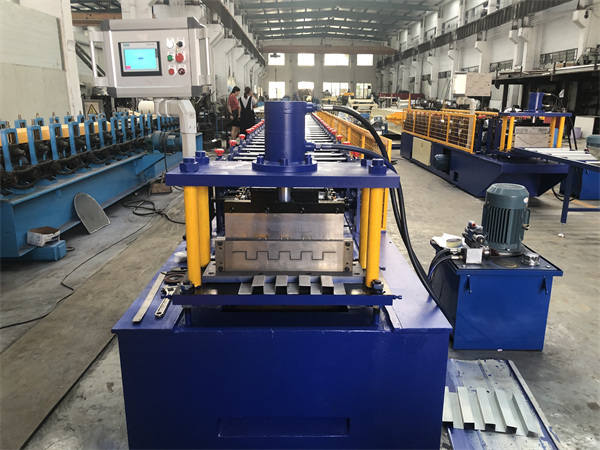
4. Advantages of Using a Sheet Roll Forming Machine
The utilization of sheet roll forming machines offers several notable advantages over traditional sheet metal fabrication methods:
- Cost-efficiency: Sheet roll forming machines automate the production process, resulting in reduced labor costs and increased efficiency. With high-speed production capabilities, manufacturers can achieve significant cost savings compared to manual fabrication methods.
- Konsistensi dan presisi: The use of specialized rolls and tooling ensures precise shaping and consistent dimensions throughout the production process. This results in uniform profiles with tight tolerances, minimizing the need for additional post-processing or adjustments.
- Keserbagunaan: Sheet roll forming machines can accommodate a wide range of materials, including steel, aluminum, copper, and various alloys. This versatility allows manufacturers to produce different profiles for diverse applications, expanding their product offerings.
- Tingkat produksi yang tinggi: Sheet roll forming machines are capable of continuous, high-speed production. With their ability to form multiple profiles simultaneously, they enable manufacturers to meet demanding production schedules and fulfill large orders efficiently.
- Material optimization: The roll forming process minimizes material waste, as it utilizes the entire length of the metal sheet. This optimization contributes to cost reduction and environmentally-friendly manufacturing practices.
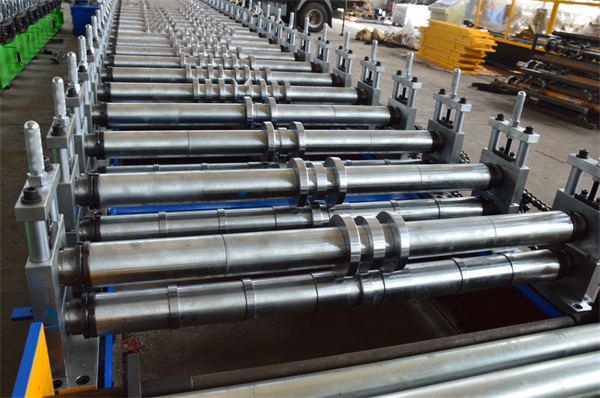
5. Types of Sheet Roll Forming Machines
There are two primary types of sheet roll forming machines, each catering to specific production requirements:
5.1 Single-Station Sheet Roll Forming Machine
The single-station sheet roll forming machine, also known as a stand-alone roll former, is suitable for producing simple profiles with straight sections. It typically consists of a set of rolls and tooling mounted on a single station. This type of machine is commonly used for basic applications such as roofing and simple cladding.
5.2 Continuous Sheet Roll Forming Machine
The continuous sheet roll forming machine, also referred to as a progressive roll former, is designed for more complex profiles with multiple bends and intricate shapes. It features a series of roll forming stations, each responsible for a specific shaping operation. The metal sheet passes through these stations in a continuous motion, gradually forming the final profile. This type of machine is ideal for high-volume production and applications requiring precise and complex profiles, such as automotive components and structural elements.
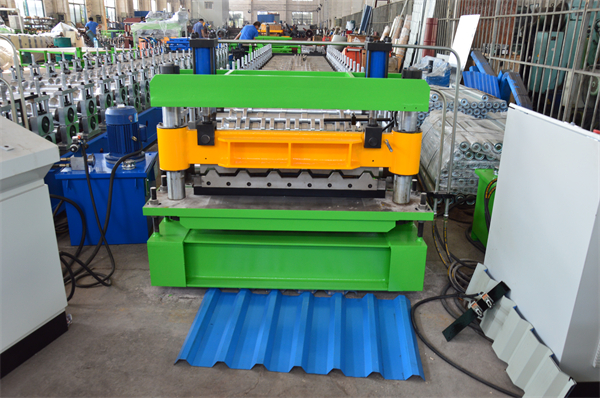
6. Applications of Sheet Roll Forming Machines
Sheet roll forming machines find applications in various industries, including construction, automotive, aerospace, and manufacturing. Some common applications include:
- Roofing and wall cladding profiles
- Ceiling and partition systems
- Window and door frames
- Automotive body components
- Electrical enclosures and cabinets
- Shelving and storage systems
- Saluran HVAC
- Bingkai panel surya
- Pintu garasi
- Fencing and gates
- Transportation and logistics equipment
The versatility of sheet roll forming machines allows manufacturers to cater to a wide range of industries and produce customized profiles tailored to specific requirements.
7. Factors to Consider When Choosing a Sheet Roll Forming Machine
Selecting the right sheet roll forming machine for your production needs is crucial. Here are some key factors to consider:
7.1 Kompatibilitas Material
Ensure that the machine is compatible with the materials you intend to work with, such as steel, aluminum, or copper. Consider the thickness and strength of the materials to ensure the machine can handle them effectively.
7.2 Production Speed
Evaluate the production speed capabilities of the machine. Depending on your production requirements, you may need a machine with higher processing speeds to meet demand.
7.3 Opsi Kustomisasi
If your application requires the production of customized profiles, choose a machine that offers flexibility in terms of roll and tooling configurations. This allows for easy adjustment and customization of profiles as per your design specifications.
7.4 Daya Tahan dan Keandalan
Invest in a machine built with high-quality materials and components to ensure its durability and longevity. Consider the reputation and track record of the manufacturer to ensure reliability and after-sales support.

8. Maintenance and Care for Sheet Roll Forming Machines
To ensure optimal performance and longevity of your sheet roll forming machine, regular maintenance and care are essential. Here are some maintenance tips:
- Regularly inspect and lubricate the machine’s moving parts, such as rollers and bearings, to prevent friction and wear.
- Keep the machine clean and free from debris or residue that may affect its performance.
- Check and adjust the alignment of the rolls periodically to maintain accurate profile shaping.
- Monitor and maintain the hydraulic or electrical systems as per the manufacturer’s recommendations.
- Train operators on proper machine operation and safety protocols to minimize the risk of damage or accidents.
By following these maintenance practices, you can prolong the lifespan of your sheet roll forming machine and ensure consistent and reliable performance.
9. Tips for Optimal Performance of Sheet Roll Forming Machines
To maximize the efficiency and output of your sheet roll forming machine, consider the following tips:
- Optimize tooling design: Work closely with tooling experts to design efficient and durable rolls and tooling for your specific profiles. Well-designed tooling reduces material waste and ensures smooth production.
- Monitor material quality: Ensure that the metal sheets used in the machine meet the required quality standards. Poor-quality materials can lead to inconsistent shaping and compromise the final product’s integrity.
- Implement quality control measures: Regularly inspect the produced profiles for dimensional accuracy, surface finish, and overall quality. Implement quality control protocols to identify and rectify any issues early in the production process.
- Invest in automation and integration: Consider integrating your sheet roll forming machine with other automated systems, such as material handling or packaging, to create a seamless and efficient production line.
- Train and empower operators: Provide comprehensive training to machine operators to ensure they understand the machine’s capabilities, maintenance requirements, and safety protocols. Empower them to troubleshoot minor issues and make adjustments for optimal performance.
By implementing these tips, you can enhance the productivity and efficiency of your sheet roll forming machine, leading to improved overall production outcomes.
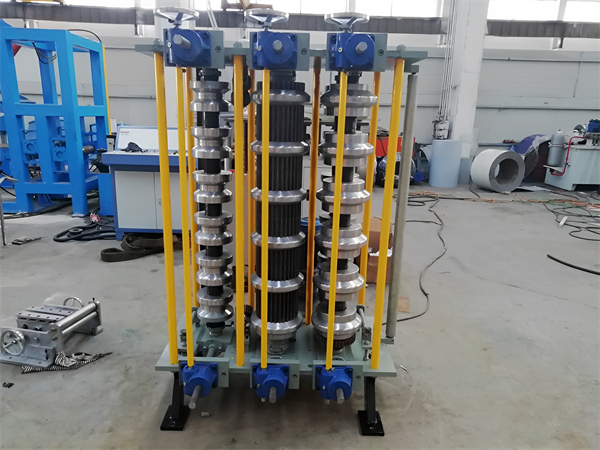
10. Common Challenges and Troubleshooting
While sheet roll forming machines offer numerous benefits, they can also encounter certain challenges. Here are some common issues and troubleshooting steps:
- Material slipping or misalignment: Check the entry guides and leveling units to ensure proper alignment and feeding of the metal sheet. Adjust the guides or rolls as needed to prevent slipping or misalignment.
- Excessive material spring-back: If the formed profile exhibits excessive spring-back, where the metal returns to its original shape after forming, consider adjusting the roll forming pressure or using materials with better elasticity. Fine-tuning the roll forming parameters can help reduce spring-back and achieve the desired shape.
- Uneven or distorted profiles: Uneven or distorted profiles may indicate issues with the roll forming process, such as improper roll alignment or worn-out rolls. Inspect the rolls for damage or wear and replace them if necessary. Ensure proper alignment and synchronization of the roll forming stations to achieve uniform profile shaping.
- Machine jams or interruptions: Machine jams can occur due to various reasons, such as material feed issues or inadequate lubrication. Clear any obstructions and ensure proper lubrication of moving parts. Regularly inspect and clean the machine to prevent debris build-up that can cause jams.
- Inconsistent production output: If you notice variations in profile dimensions or quality, review the tooling design and roll configurations. Ensure that the rolls are properly positioned and aligned. Check for any worn-out or damaged tooling components and replace them as needed. Conduct regular inspections and maintenance to maintain consistent production output.
If you encounter persistent issues or complex troubleshooting requirements, consult the machine manufacturer or a qualified technician for assistance. They can provide expert guidance and support in resolving any challenges you may face.
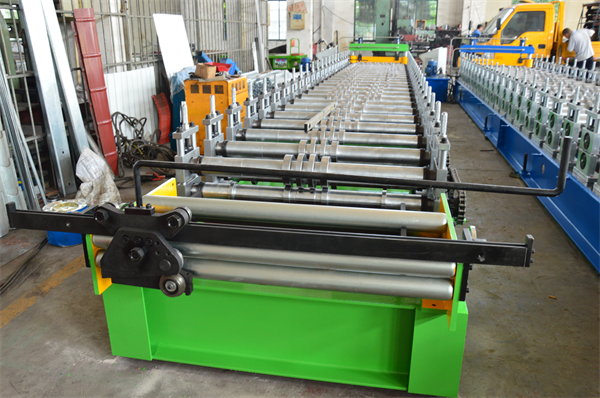
11. Safety Precautions When Operating Sheet Roll Forming Machines
While sheet roll forming machines offer increased efficiency and productivity, it’s crucial to prioritize safety during their operation. Here are some safety precautions to follow:
- Training and education: Provide comprehensive training to operators on the safe operation of the machine, including proper handling of materials, emergency procedures, and the use of personal protective equipment (PPE).
- PPE usage: Ensure that operators wear appropriate PPE, including safety glasses, gloves, hearing protection, and steel-toed footwear, to protect against potential hazards.
- Machine guards and safety devices: Install and maintain machine guards, safety interlocks, and emergency stop buttons to prevent access to hazardous areas and enable quick shutdown in case of emergencies.
- Lockout/tagout procedures: Establish lockout/tagout procedures to secure the machine during maintenance or repair activities, preventing accidental startup and ensuring the safety of personnel.
- Pemeliharaan dan inspeksi rutin: Conduct routine inspections and maintenance of the machine to identify and address any potential safety risks, such as faulty wiring or worn-out safety components.
By adhering to these safety precautions, you can create a secure working environment and minimize the risk of accidents or injuries associated with sheet roll forming machine operations.
12. Future Trends in Sheet Roll Forming Technology
The sheet roll forming industry continues to evolve, driven by advancements in technology and market demands. Some future trends to watch for in sheet roll forming technology include:
- Digitalization and automation: Increasing integration of digital technologies, such as machine learning, artificial intelligence, and real-time monitoring systems, to optimize production processes, improve quality control, and enhance overall efficiency.
- Kemampuan kustomisasi: Further development of roll forming machines with advanced customization features, allowing for rapid and flexible production of highly customized profiles to meet individual customer requirements.
- Efisiensi energi: Implementation of energy-efficient systems and technologies in sheet roll forming machines to minimize energy consumption and reduce the environmental impact of the manufacturing process.
- Material advancements: Exploration of new materials and alloys suitable for roll forming, enabling the production of lightweight yet strong profiles for various applications.
- Smart manufacturing: Integration of Industry 4.0 concepts, such as IoT (Internet of Things) connectivity and data analytics, to create smart manufacturing environments that enhance productivity, quality control, and predictive maintenance.
As technology continues to advance, sheet roll forming machines will become even more versatile, efficient, and capable of meeting the evolving needs of the manufacturing industry. By embracing these future trends, manufacturers can stay competitive, reduce costs, and enhance their production capabilities.
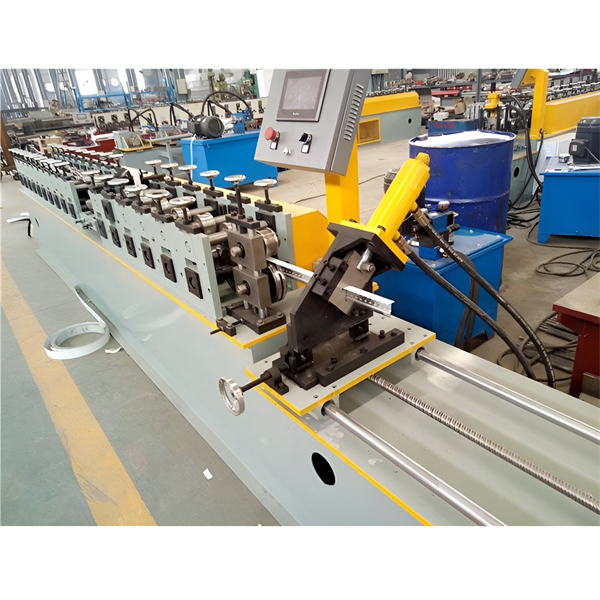
13. Kesimpulan
Sheet roll forming machines have revolutionized the sheet metal fabrication industry by offering efficient, precise, and versatile solutions for producing custom-shaped profiles. Their automated operation, high production rates, and material optimization benefits make them indispensable for various applications in construction, automotive, and other industries. By considering factors such as material compatibility, production speed, and customization options, manufacturers can choose the right machine to meet their specific needs. Regular maintenance, adherence to safety precautions, and implementing optimization tips ensure optimal performance and longevity of sheet roll forming machines. As the industry continues to evolve, embracing trends such as digitalization, customization capabilities, and energy efficiency will further enhance the capabilities of sheet roll forming technology, leading to more efficient and sustainable manufacturing processes.
FAQ (Pertanyaan yang Sering Diajukan)
1. How long does it take to set up a sheet roll forming machine?
The setup time for a sheet roll forming machine varies depending on factors such as machine complexity, the type of profile being produced, and operator experience. It typically ranges from a few minutes to a couple of hours.
2. Can sheet roll forming machines be used for stainless steel materials?
Yes, sheet roll forming machines can be used for stainless steel materials. However, it’s important to ensure that the machine is designed and equipped to handle the specific properties and thickness of stainless steel.
3. Are sheet roll forming machines suitable for large-scale production?
Yes, sheet roll forming machines are highly suitable for large-scale production. Their high-speed capabilities, consistent output quality, and ability to produce multiple profiles simultaneously make them ideal for fulfilling large orders efficiently.
4. What are some key maintenance tasks for sheet roll forming machines?
Key maintenance tasks for sheet roll forming machines include regular inspection and lubrication of moving parts, cleaning to prevent debris build-up, alignment checks, and monitoring hydraulic or electrical systems. Following manufacturer guidelines for maintenance is crucial to ensure optimal performance.
5. Can sheet roll forming machines be customized for specific product designs?
Yes, sheet roll forming machines can be customized for specific product designs. Manufacturers can work with machine suppliers to develop custom rolls and tooling configurations that align with their unique profile requirements. Customization options allow for greater flexibility and versatility in production.
